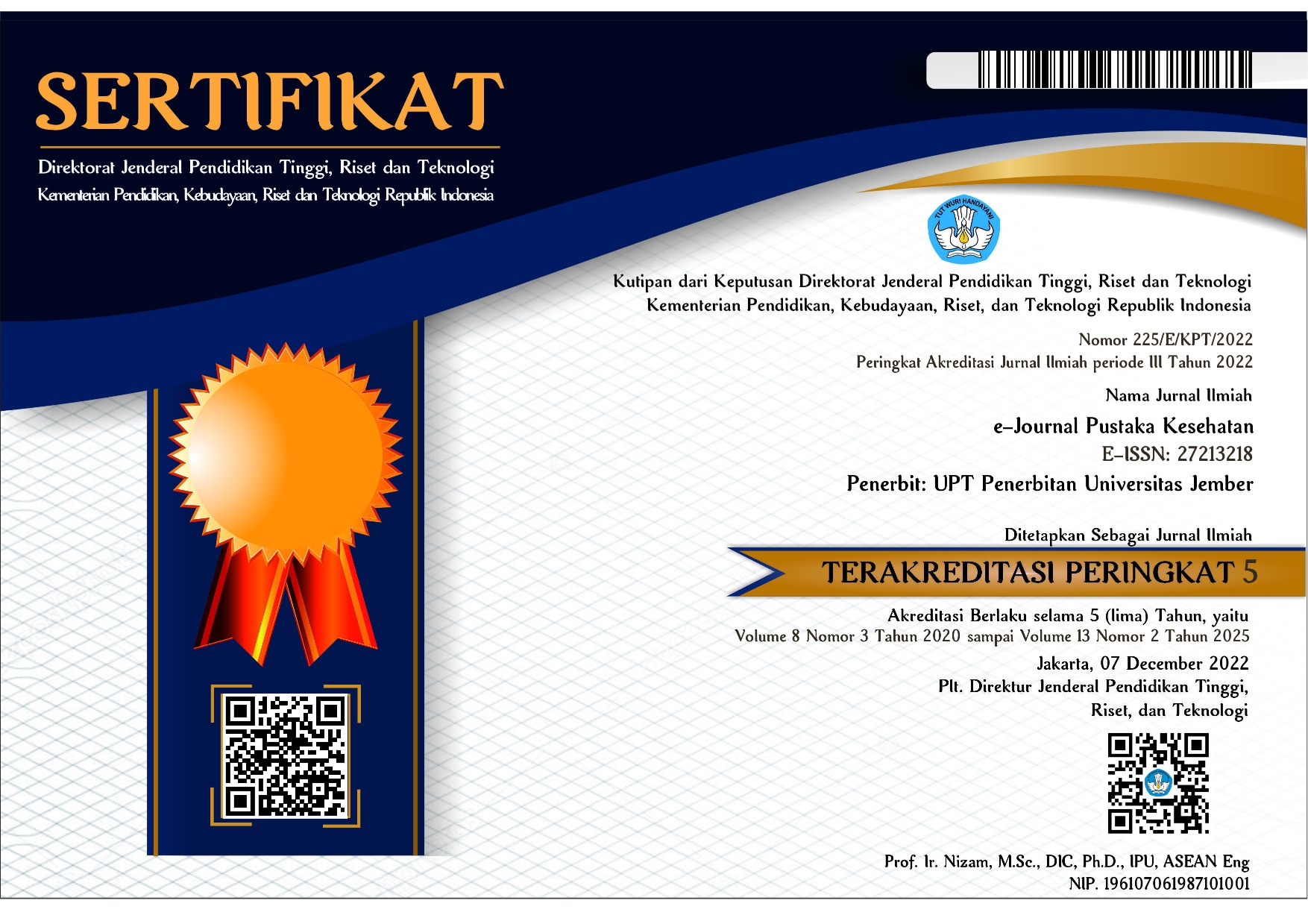Gambaran Intervensi Family Centered Care pada Pasien Balita di RS Perkebunan Wilayah Karesidenan Besuki Raya
Abstract
The implementation of family-centered care in pediatric hospitals in developed countries has been well-standardized. But, in Indonesia, it can be implemented with the possibility to be realized ideally is not easy because of many health workers do not understand family-centered care properly. The purpose of this study is to describe the application of Family Centered Care in toddler patients in inpatient rooms conducted by nurses. This research is a descriptive study with a cross-sectional approach using a purposive sampling technique. The study was conducted at Kaliwates General Hospital, Jember Klinik Hospital and Elizabeth Situbondo Hospital Data collection was performed using a Family Centered Care questionnaire. Data Collection was carried out from September 2019 to December 2019. The study Participants were 98 families selected by purposive sampling technique. Data were collected techniques using in-depth interviews and documentation. The results showed that the majority of families (83.7%) were good. Nurses can be good counselors and educators in meeting the needs of families and children in the hospital to have a good cooperative relationship between family and nurses. Nurses can improve the quality of their services by understanding more deeply about family needs and strengths.
References
[2] KEMENPPPA. 2015. Profil Anak Indoensia 2015. [Internet]. Available from: https://www.kemenpppa.go.id/lib/uploads/slider/c7c3e-profil-anak-indonesia-2015.pdf
[3] Aziz A. Pengantar Ilmu Keperawatan Anak 1. Edisi 1. Jakarta: Penerbit Salemba Medika. 2005.
[4] Kuo DZ, Houtrow AJ, Arango P, Neff JM, Á Family-centered, dan Á. Patient-centered. 2012. Family-centered care: current applications and future directions in pediatric health care american academy of pediatrics. 297–305.
[5] Supartini Y. Buku Ajar Konsep Dasar Keperawatan Anak. Jakarta: EGC. 2005.
[6] Festini F. 2014. Family-centered care. Italian Journal of Pediatrics. 40(1):A33. DOI:10.1186/1824-7288-40-S1-A33.
[7] Maulana. 2016. Henny Suzana Mediani, M.Ng., PhD., "Keperawatan Anak Berpusat pada Keluarga dan Pencegahan Trauma". [Internet] https://www.unpad.ac.id/profil/henny-suzana-mediani-m-ng-phd keperawatan-anak-berpusat-pada-keluarga-dan-pencegahan-trauma/
[8] Smith W. 2018. Concept analysis of family-centered care of hospitalized pediatric patients. Journal of Pediatric Nursing. 42:57–64. DOI: 10.1016/j.pedn.2018.06.014.
[9] Makworo D, et al. 2016. Implementation of Family Centered Care in Child Health Nursing: Kenya Paediatric Nurses’ Experiences. Nurse Care Open Acces Journal.1(3):49‒51.
[10] Purmailani. 2014. Family Centered Care Pada Perawatan Anak Di Rsud Soe Timor Tengah Selatan. Jurnal Riset Kesehatan. DOI:http://dx.doi.org/10.31983/jrk.v8i1.3918
[11] Neal A, Frost M, Khun J, Grees A, Cleveland BG, Kersten R. 2007, Family Centered Care Within An Infant-Toddler Unit. Pediatric Nursing, 33(6).
[12] Curley MAQ, Hunsberger M, Harris SK. 2013, Psychometric Evaluation of the Family-Centered Care Scale for Pediatric Acute Care Nursing. Nursing Research. 62(3):160–168.
[13] Khadijah. Perkembangan Kognitif anak usia dini. Edisi 1. Jakarta: Penerbit Perdana Mulya Sarana. 2016.
[14] Sue DW. Microaggressions in eveyday life: Race, gender, and sexual orientation. Jhon Wiley & Sons Inc. 2010.
[15] Somantri I. 2016. Efektifitas Terapi Mendongeng Terhadap Kecemasan Anak Usia Toddler dan Prasekolah Saat Tindakan Keperawatan. Jurnal Keperawatan Padjajaran. 4(3):248-254. DOI:https://doi.org/10.24198/jkp.v4i3.287.
[16] Vlassof C. 2007. Gender Differences in Determinants and Consequences of Health and Illness. Journal of Health, Population and Population. 25(1): 47-61.
[19] Zagrosek VR. (2012). Sex and gender differences in health. EMBO Reports. 13(7): 596-603. DOI: 10.1038/embor.2012.87
[20] Rostami et al. 2015. Effects of family centered care on the satisfaction of parents of children hospitalized in pediatric wards in a pediatric ward in Chaloos in 2012. Electron Physician. 7(2): 1072-1084. doi: 10.14661/2015.1078-1084.
[21] Tanaem GH. 2019. Family Centered Care Pada Perawatan Anak Di RSUD SOE Timor Tengah Selatan. Jurnal Riset Kesehatan. 8(1): 21-27. DOI: 10.31983/jrk.v8i1.3918.
[22] Notoatmodjo S. 2010. Metodologi Penelitian Kesehatan. Cetakan kedua edisi revisi. Jakarta: Rhineka Cipta
[23] Hill C. 2017. Family-Centered Care From the Perspective of Parents of Children Cared for in a Pediatric Intensive Care Unit: An Integrative Review. Journal of Pediatric Nurse.6:180-190. DOI: 10.1016/j.pedn.2017.11.007
[24] Tina S. 2017. Family Centered care and its exposure. Nursing Life Journal.
[25] Zeanah et al. 2017. Separating Families at the Border-Consequences for Children’s Health and Well-Being. New England Journal of Medicine.376(24).
[26] Humphreys KL. 2018. Future Directions in the Study and Treatment of Parent-Child Separation. Journal of Clinical Child & Adolescent Psychology. 48(1): 166-178. DOI:https://doi.org/10.1080/15374416.2018.1534209
[27] Bellou P., Gerogianni K,G. 2014. The Contribution of Family in the care f Patient in the hospital. Health Science Journal.
[28] Ayu S. 2016. Perilaku Ibu Dalam Pemenuhan Kebutuhan Asah, Asih Dan Asuh Anak Dengan Leukemia. [Serial Online] https://e-journal.unair.ac.id
[29] Seran MY, Krisnana I, Rachmawati PD. 2019. Slime As Playing Therapy on Response of Biological, Psycological and Eating Behaviour of Preschool in Hospital. Pediomaternal Nursing Journal. 5(1). doi: dx.doi.org/10.20473/pmnj.v5i1.11979
[30] Nadhifati L. 2018. Terapi Bermain Untuk Menurunkan Stres Hospitalisasi Pada Pasien Anak Usia Prasekolah. Available from: https://digilib.uin-suka.ac.id/30288/
[31] Hadian Z., Sharif F, Rakhshan, Pishva N, Jahanpour F. 2015. The Obstacles against Nurse-Family Communcation in Family-Centered Care in Neonatal Intensive Care Unit: a Qualitative Study. Journal of caring Sciences. 4(3): 2017-216. doi: 10.15171/jcs.2015.021.
[32] Sarfika R, Maisa EA, Freska W. 2018. Buku Ajar Keperawatan Dasar 2 Komunikasi Terapeutik Dalam Keperawatan.. Cetakan 1. Padang: Andalas University Press
[33] Suwarni W, Murtutik A, Lilis. 2013. Hubungan Frekuensi Hospitalisasi anak Dengan Kemampuan Perkembangan Motorik Kasar Pada Anak Preschool Penderita Leukimia di RSUD Dr. Moewardi. JIKI.
[34] McCabe, M. 2014. Impact of Family Presence in the Healthcare Setting. [Serial Online] Availbale from: https://digitalcommons.liberty.edu/honors/459
[35] Rahmawati IMH, Ratnawati R, Rachmawati SD. 2018. Pengalaman Perawat Dalam Memberikan Layanan Keperawatan Jiwa Pada Pecandu NAPZA di Pusat Rehabilitasi Badan Narkotika Nasional Karesidenan Kediri. Jurnal Ilmu Keperawatan: Journal of Nursing Science. 4(2).

This work is licensed under a Creative Commons Attribution-ShareAlike 4.0 International License.
e-Journal Pustaka Kesehatan has CC-BY-SA or an equivalent license as the optimal license for the publication, distribution, use, and reuse of scholarly work. Authors who publish with this journal retain copyright and grant the journal right of first publication with the work simultaneously licensed under a Creative Commons Attribution-ShareAlike 4.0 International License that allows others to share the work with an acknowledgment of the work's authorship and initial publication in this journal.











